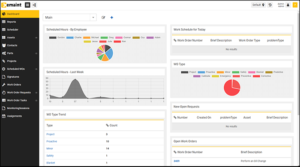Many organizations achieve CMMS implementation success because they do their homework and apply best practices. If you’re a facility or plant maintenance professional looking for the best Computerized Maintenance Management System (CMMS) software, you might come across some scary estimates about implementation failures — 40% to 90%.
Don’t let that stop you from moving ahead and accomplishing your own CMMS implementation success.
What Signifies Successful CMMS Implementation?
In broad terms, a successful CMMS implementation usually happens because the organization had the proper infrastructure, maximized the tool, and prepared and planned the implementation satisfactorily.

CMMS success takes planning and preparation.
Ultimately, CMMS implementation success means the maintenance team uses the preventive maintenance tool as intended and the maintenance software is properly optimized. The result? Maintenance management processes and workflows improve and therefore, the organization’s overall business value increased.
Whether you’re considering implementing a CMMS at multiple sites or just one, it’s wise to understand why some implementations succeed and others don’t. CMMS case studies contain tons of valuable information about how organizations achieve CMMS implementation success.
7 Top CMMS Case Study Implementation Success Examples
A CMMS implementation can fail at any stage: before, during, or after completion. Subsequently, the amount of information related to CMMS implementation success and failure can be overwhelming. So, here are some short eMaint CMMS case study excerpts from customers about how several organizations succeeded.
Each example concerns a multi-site rollout, but all the stories also apply to a single CMMS implementation.
1. CMMS Supplier, Customer Service, and Support
CMMS implementation success doesn’t just depend on you. It also depends on your vendor. Choosing the right CMMS software provider is a key success factor. The customer service and support you receive from your supplier should continue throughout the lifecycle of your CMMS.
Why?
Your supplier ought to remain a valuable partner throughout your organization’s reliability journey and help keep you on the right track. Once you buy the CMMS software, that’s just the start of your success story.
Some vendors stop support once the system goes “live.” With eMaint, our CMMS support teams stick with you before, during, and after the rollout. And you won’t get nickel and dimed constantly.
A snack foods manufacturer wanted to standardize workflows and processes and gain a complete view of maintenance operations at its nine locations. The organization chose eMaint CMMS software because of its reputation for unbeatable customer service and support and experience with multi-site implementations.
“I think having the support and being able to have access to getting help from our CMMS vendor whenever is great. There are not a lot of systems that will let you make changes without mentioning, ‘Hey, you’ll need to pay for this. You’ll need to pay for that,’ kind of thing. And I know it’s not all about money, but it is nice to be able to say, ‘Hey, I need this done. Help me walk through it.’”
— Snack foods manufacturer
2. Start Small with a Free CMMS Implementation Pilot
Running a CMMS trial is one of the best ways to test out the system. A pilot helps ensure the software fits your needs, whether you want to implement a CMMS at one site or 75 sites.
Why?
With a CMMS pilot, you get a feel for what the system does. Especially how it can solve many maintenance management problems.
A water and wastewater services company decided to implement a CMMS to help connect its 75 separate utility operations. They also wanted to streamline the maintenance of its over 30,000 machines for their municipal, industrial, and commercial customers.
Before deploying eMaint, the organization participated in a CMMS pilot enabling them to create an implementation template.
“We started with one system implementation, but the pilot consisted of three eMaint implementations serving different utilities. So, we hit hard on one, and then we moved into the second and third. We were using many diverse systems, depending on where we were. So, by being able to move to a common platform and with the visibility across all the systems, it really gives us the strength from the amount of information we can pull together.”
-Wastewater and Water Facilities Services
3. Determine How You’ll Use Your CMMS Data
One of the many benefits of having maintenance management software, like the eMaint CMMS, is the ability to track continuous improvement efforts and see areas needing attention.
Why?
Before CMMS implementation, an organization should know how the data will be managed and who will look at it. Otherwise, who will you maximize its power?

Leverage your CMMS data
Using the data stored in the eMaint CMMS, a water and wastewater services company identified essential metrics and key performance indicators (KPIs) from the beginning. They established a review process to track KPIs and continuous improvement efforts.
“We get report metrics out of the eMaint consolidated account that summarizes where everyone’s work order backlog is. As part of our monthly review, we look for possible yellow flags, indicators that maybe there’s something wrong. We can then get the right support functions in place before something becomes a problem.”
-Water/wastewater operations
4. Commit to Maintaining Standardization and CMMS Data Integrity
CMMS asset data benefits the entire organization when used strategically. But only if the information is accurate.
Why?
If your data isn’t reliable because of incorrect or missing records, you lose one of the most significant CMMS advantages. Choose a flexible system that allows you to configure forms that require field entries or signoffs before closing a work order to safeguard data integrity and standardization.
A global automotive parts provider wanted to standardize operations at its 12 plants and make it sustainable. Each plant used some type of maintenance management system, but none were the same.
“With the support of our CMMS provider, we have a better structure. We gave everybody rules to follow so that plants look the same, everybody has the same capabilities, and everybody has the same reports. We basically created a system that if they did not follow it, we would take control over it. It gave them a little bit more incentive to follow.”
-Global Automotive Parts Supplier
5. Plan and Prepare for CMMS Implementation Success
A successful CMMS implementation doesn’t just happen. It takes careful planning, preparation, and time.
Why?
Detailed organization, joint teamwork, the right CMMS, and a relentless commitment to reliability helped a services industry company move through a seven-phase implementation.
A water and wastewater company’s various contract operations customers used a maintenance management system. And each client operated independently, preventing the organization from obtaining systemwide visibility. The company’s desire to consolidate everyone under one CMMS presented major challenges, including 46 planned rollouts, making planning and preparation crucial.
“Part of the key to our success was that we had a very well-organized and coordinated implementation. A lot of effort went into planning the process and identifying roles, responsibilities and holding people accountable. And that is key to how we were able to accomplish the amount of work that we got done in the timeframe that we did.”
-Services Industry
6. Train Users on the CMMS Software
A CMMS is only worthwhile if employees are adequately trained and use it.
Why?
Some companies skip training, which often stalls usage and system optimization. eMaint offers in-person and web-based training and boot camps, webinars, and workshops to help ensure CMMS implementation success.
A cardboard manufacturer needed CMMS software to help manage increasing product demands caused by the packaging needs of online e-commerce companies such as Amazon.
The company chose to have in-person training. They also took advantage of the eMaint CMMS sandbox, letting maintenance teams try out the system before going live.
“Having the trainer here, going through specifics, running it in the sandbox where they would not be intimidated or concerned with making mistakes was a turning point. It really helped our users.”
-Corrugated cardboard manufacturer
7. Ensure Team Usage to Assure a Quick CMMS ROI
You’ve heard the term “use it or lose it.” If your team doesn’t know how to or want to use the CMMS, you won’t achieve implementation success or the expected return on investment (ROI).
Why?
If nobody fully understands the full power of the CMMS software, how can it be maximized?
A snack foods manufacturer overcame this common dilemma by appointing a team expert. The expert repeatedly showed technicians and other users how easy eMaint was to use.
“We chose a system that’s easy to use. Once we started using the capabilities, we understood and exploited more of its functionality. The more we’ve used it, the more we’ve seen a return on investment.”
-Snack foods manufacturer
